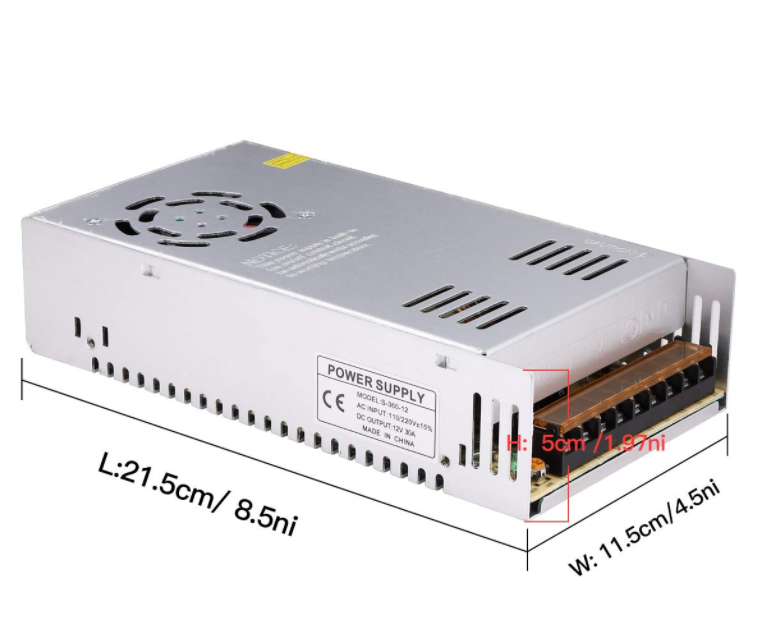Whether you're building a DIY electronics project, developing industrial equipment, or designing a new consumer device, choosing the right AC to DC power supply is a crucial decision that can affect everything from performance and safety to long-term reliability. With countless models, specifications, and form factors on the market, making the right choice requires more than just matching voltage and current ratings. This guide walks you through the key considerations to help you select the ideal power supply for your needs.

The first and most essential step is to understand what your device or system actually needs in terms of power:
Voltage (V): Determine the DC voltage your device requires. Common values include 5V, 12V, 24V, or 48V.
Current (A): Calculate the maximum current draw of your system under full load.
Power (W): Multiply voltage and current (P = V × A) to get the wattage. Always add 20–30% headroom to ensure reliability and accommodate surges or future upgrades.
Tip: Over-sizing slightly is safer than under-sizing, but excessively over-sizing may lead to inefficient operation or unnecessary cost.
Regulated power supplies provide stable voltage regardless of load changes or input fluctuations. They're ideal for sensitive electronics, digital circuits, and communication systems.
Unregulated power supplies are simpler and cheaper but their output can vary. They may be acceptable for resistive loads like motors or heaters.
Rule of thumb: If your application involves microcontrollers, sensors, or communication modules, go with a regulated supply.
Power supplies come in various physical forms, each suited to different environments:
Wall-mounted (plug-in): Great for consumer electronics and small projects.
Desktop adapters: Common for test benches and development kits.
Enclosed chassis (metal box): Suitable for industrial or embedded systems.
Open frame or PCB mount: Designed for integration inside equipment.
DIN rail: Perfect for control panels and factory automation setups.
Tip: Always check the available space in your project enclosure and the thermal requirements before choosing a form factor.
Efficiency matters more than many people think. Higher-efficiency power supplies waste less energy as heat, which means:
Lower electricity costs over time.
Reduced need for additional cooling (fans or heat sinks).
Longer lifespan of components.
Watch for: Power supplies typically operate at 80–95% efficiency. Look for “Energy Star” or “80 PLUS” certifications for quality assurance.
Safety is non-negotiable. A reliable AC to DC power supply should offer:
Short-circuit protection
Overvoltage protection
Overcurrent protection
Thermal shutdown
Also, ensure the product has relevant certifications based on your region or industry (UL, CE, FCC, RoHS, etc.).
Especially important: For medical, aerospace, or industrial environments, certifications are legally required—not optional.
Ensure the power supply supports your input AC voltage. Common ranges include:
85–264V AC: Universal input, suitable for global use.
110V or 220V only: Region-specific input.
Bonus: If you're deploying internationally or in unstable power grids, choose supplies with wide input ranges and good surge immunity.
Consider environmental factors like:
Operating temperature
Humidity and dust levels
Vibration or shock exposure
If your application is outdoors or in a harsh environment, look for power supplies with IP ratings (e.g., IP65 or IP67), ruggedized enclosures, or conformal coatings.
Mounting: Will it be inside a sealed enclosure? On a panel? These affect thermal management and access to wiring.
While budget is important, don’t just go for the cheapest option. Consider:
Mean Time Between Failures (MTBF): Higher MTBF = longer lifespan.
Warranty and support: Reliable manufacturers often offer long-term warranties.
Repair vs. replace: Industrial-grade power supplies may be repairable, while cheaper ones are often disposable.
Insight: A $20 power supply failure could cause a $1,000 device to crash. Choose wisely.
Choosing the right AC to DC power supply is not just about volts and amps—it’s about ensuring safety, reliability, and performance for your project. By evaluating your specific needs across electrical, mechanical, environmental, and regulatory dimensions, you can select a power supply that fits like a glove.
Remember: the power supply may not be the star of your system, but it is the foundation—and every great project deserves a solid foundation.